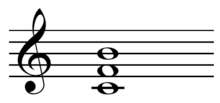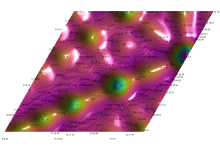Chord (music)
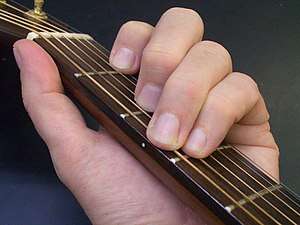
A chord, in music, is any harmonic set of pitches consisting of two or more (usually three or more) notes (also called "pitches") that are heard as if sounding simultaneously.[1][2] (For many practical and theoretical purposes, arpeggios and broken chords, or sequences of chord tones, may also be considered as chords.)
Chords and sequences of chords are frequently used in modern West African[3] and Oceanic music,[4] Western classical music, and Western popular music; yet, they are absent from the music of many other parts of the world.[5]
In tonal Western classical music (music with a tonic key or "home key"), the most frequently encountered chords are triads, so called because they consist of three distinct notes: the root note, and Intervals of a third and a fifth above the root note. Other chords with more than three notes include added tone chords, extended chords and tone clusters, which are used in contemporary classical music, jazz and other genres.
An ordered series of chords is called a chord progression.[6] One example of a widely used chord progression in Western traditional music and blues is the 12 bar blues progression. Although any chord may in principle be followed by any other chord, certain patterns of chords are more common in Western music, and some patterns have been accepted as establishing the key (tonic note) in common-practice harmony–notably the movement between tonic and dominant chords. To describe this, Western music theory has developed the practice of numbering chords using Roman numerals[7] which represent the number of diatonic steps up from the tonic note of the scale.
Common ways of notating or representing chords[8] in Western music (other than conventional staff notation) include Roman numerals, the Nashville number system, figured bass, macro symbols (sometimes used in modern musicology), and chord charts.
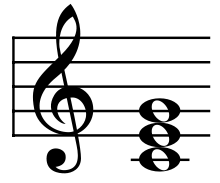
Definition and history
The English word chord derives from Middle English cord, a shortening of accord[9] in the original sense of agreement and later, harmonious sound.[10] A sequence of chords is known as a chord progression or harmonic progression. These are frequently used in Western music.[5] A chord progression "aims for a definite goal" of establishing (or contradicting) a tonality founded on a key, root or tonic chord.[7] The study of harmony involves chords and chord progressions, and the principles of connection that govern them.[11]
Ottó Károlyi[12] writes that, "Two or more notes sounded simultaneously are known as a chord," though, since instances of any given note in different octaves may be taken as the same note, it is more precise for the purposes of analysis to speak of distinct pitch classes. Furthermore, as three notes are needed to define any common chord, three is often taken as the minimum number of notes that form a definite chord.[13] Hence Andrew Surmani, for example, (2004, p. 72) states, "When three or more notes are sounded together, the combination is called a chord." George T. Jones (1994, p. 43) agrees: "Two tones sounding together are usually termed an interval, while three or more tones are called a chord." According to Monath (1984, p. 37); "A chord is a combination of three or more tones sounded simultaneously," and the distances between the tones are called intervals. However sonorities of two pitches, or even single-note melodies, are commonly heard as implying chords.[14] A simple example of two notes being interpreted as a chord is when the root and third are played, but the fifth is omitted. In the key of C major, if the music comes to rest on the two notes G and B, most listeners will hear this as a G major chord.
Since a chord may be understood as such even when all its notes are not simultaneously audible, there has been some academic discussion regarding the point at which a group of notes may be called a chord. Jean-Jacques Nattiez (1990, p. 218) explains that, "We can encounter 'pure chords' in a musical work," such as in the Promenade of Modest Mussorgsky's Pictures at an Exhibition but, "Often, we must go from a textual given to a more abstract representation of the chords being used," as in Claude Debussy's Première Arabesque.

In the medieval era, early Christian hymns featured organum (which used the simultaneous perfect intervals of a fourth, a fifth, and an octave[15]), with chord progressions and harmony an incidental result of the emphasis on melodic lines during the medieval and then Renaissance (15th to 17th centuries).[16][17]
The Baroque period, the 17th and 18th centuries, began to feature the major and minor scale based tonal system and harmony, including chord progressions and circle progressions.[18] It was in the Baroque period that the accompaniment of melodies with chords was developed, as in figured bass,[17] and the familiar cadences (perfect authentic, etc.).[19] In the Renaissance, certain dissonant sonorities that suggest the dominant seventh occurred with frequency.[20] In the Baroque period the dominant seventh proper was introduced, and was in constant use in the Classical and Romantic periods.[20] The leading-tone seventh appeared in the Baroque period and remains in use.[21] Composers began to use nondominant seventh chords in the Baroque period. They became frequent in the Classical period, gave way to altered dominants in the Romantic period, and underwent a resurgence in the Post-Romantic and Impressionistic period.[22]
The Romantic period, the 19th century, featured increased chromaticism.[18] Composers began to use secondary dominants in the Baroque, and they became common in the Romantic period.[23] Many contemporary popular Western genres continue to rely on simple diatonic harmony, though far from universally:[24] notable exceptions include the music of film scores, which often use chromatic, atonal or post-tonal harmony, and modern jazz (especially circa 1960), in which chords may include up to seven notes (and occasionally more).[25] When referring to chords that do not function as harmony, such as in atonal music, the term "sonority" is often used specifically to avoid any tonal implications of the word "chord".
Triads consist of three notes; the root or first note, the third, and the fifth.[26] For example, the C major scale consists of the notes C D E F G A B: a triad can be constructed on any note of such a major scale, and all are minor or major except the triad on the seventh or leading-tone, which is a diminished chord. A triad formed using the note C itself consists of C (the root note), E (the third note of the scale) and G (the fifth note of the scale). The interval from C to E is of four semitones, a major third, and so this triad is called C Major. A triad formed upon the same scale but with D as the root note, D (root), F (third), A (fifth), on the other hand, has only three semitones between the root and third and is called D minor, a minor triad.
Notation

Chords can be represented in various ways. The most common notation systems are:[18]
- Plain staff notation, used in classical music
- Roman numerals, commonly used in harmonic analysis to denote the scale step on which the chord is built.[7]
- Figured bass, much used in the Baroque era, uses numbers added to a bass line written on staff (music), to enable keyboard players to improvise chords with the right hand while playing the bass with their left.
- Macro symbols, sometimes used in modern musicology, to denote chord root and quality.
- Various chord names and symbols used in popular music lead sheets, fake books, and chord charts, to quickly lay out the harmonic groundplan of a piece so that the musician may improvise, jam, or vamp on it.
Roman numerals
While scale degrees are typically represented in musical analysis or musicology articles with Arabic numerals (e.g., 1, 2, 3..., sometimes with a circumflex above the numeral: ![]()
![]()
![]()
Roman numerals can also be used in stringed instrument notation to indicate the position or string to play. In some string music, the string on which it is suggested that the performer play the note is indicated with a Roman numeral (e.g., on a four-string orchestral string instrument (violin, viola, cello or double bass), I indicates the highest-pitched, thinnest string and IV indicates the lowest-pitched, thickest bass string). In some orchestral parts, chamber music and solo works for string instruments, the composer specifies to the performer which string should be used with the Roman numeral. Alternately, the note name of the string that the composer wishes the performer to use are stated using letters (e.g., "sul G" means "play on the G string").
Figured bass notation
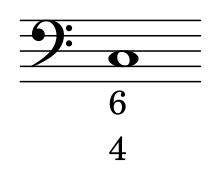
Figured bass or thoroughbass is a kind of musical notation used in almost all Baroque music (c. 1600–1750), though rarely in music from later than 1750, to indicate harmonies in relation to a conventionally written bass line. Figured bass is closely associated with chord-playing basso continuo accompaniment instruments, which include harpsichord, pipe organ and lute. Added numbers, symbols and accidentals beneath the staff indicate at the intervals to play, the numbers stand for the number of scale steps above the written note to play the figured notes. In the 2010s, some classical musicians who specialize in music from the Baroque era can still perform chords using figured bass notation; in many cases, however, the chord-playing performers read a fully notated accompaniment that has been prepared for the piece by the music publisher. Such a part, with fully written-out chords, is called a "realization" of the figured bass part.
In the illustration the bass note is a C, and the numbers 4 and 6 indicate that notes a fourth and a sixth above, that is F and A, should be played, giving the second inversion of the F major triad. If no numbers are written beneath a bass note, this is assumed to indicate the figure 5,3, which calls for a third and a fifth above the bass note (i.e., a root position triad).
Macro analysis
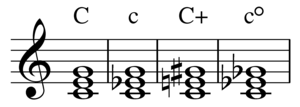
Macro analysis is used by musicologists, music theorists and advanced university music students to analyze songs and pieces. Macro analysis uses upper-case and lower-case letters to indicate the roots of chords, followed by symbols that specify the chord quality.[28]
Basics
In most genres of popular music, including jazz, pop, and rock, a chord name and the corresponding symbol are typically composed of one or more parts. In these genres, chord-playing musicians in the rhythm section (e.g., electric guitar, acoustic guitar, piano, Hammond organ, etc.) typically improvise the specific "voicing" of each chord from a song's chord progression by interpreting the written chord symbols appearing in the lead sheet or fake book. Normally, these chord symbols include:
- A (big) letter indicating the root note (e.g. C).
- A symbol or abbreviation indicating the chord quality (e.g. minor, aug or o ). (If no chord quality is specified, the chord is assumed to be a Major triad by default).
- Number(s) indicating the stacked intervals above the root note (e.g. 7 or 13).
- Additional musical symbols or abbreviations for special alterations (e.g. ♭5, ♯5 or add13).
- An added slash "/" and an upper case letter indicates that a bass note other than the root should be played. (e.g. C/F indicates that an C Major triad should be played with an added F in the bass).
Chord qualities are related with the qualities of the component intervals that define the chord. The main chord qualities are:
- Major and minor (a chord is "Major" by default and altered with added info: "C" = C Major, "Cm" = c minor).
- augmented, diminished, and half-diminished,
- dominant seventh.
Symbols
The symbols used for notating chords are:
- m or min for minor (the minor quality should always be written in small letters),[29]
- − A hyphen/minus symbol is sometimes used for minor, this is common in jazz lead sheets
- M, Ma, Maj, or no symbol for Major (the Major quality should always be written with (a) Capital letter),
- Δ The symbol Δ is also commonly used for Major. (In a jazz context, this typically indicates that the player should use any suitable chord of a major quality, for example a a Major seventh chord or a 6/9 chord. In a lot of jazz styles, an unembellished major triad is rarely if ever played, but in a lead sheet the choice of which major quality chord to use is left to the performer)
- + or aug is used for augmented (A or a is not used),
- o or dim is used for diminished (d is not used),
- ø is used for half-diminished (in some fake books, the abbreviation m7(♭5) is used as an equivalent symbol),
- 2 Is mostly used as an extra note in a chord (e.g. add2, sus2),
- 3 Is the minor or Major quality of the chord and hardly ever gets written as a number,
- 4 Is mostly used as an extra note in a chord (e.g. add4, sus4),
- 5 Is the (perfect) fifth of the chord and is only written as a number when altered (e.g. F7(♭5)). (exception, power chords; see below),
- 6 is used for a sixth chord. There are no rules if the 6 replaces the 5th or not.
- 7 is used for a dominant 7th chord. However, if Maj7, M7 or Δ7 is indicated, this is a Major 7th chord (e.g. GM7 or FΔ7). Very rarely, also dom is used for dominant 7th,
- 9 is used for a ninth chord, which in jazz usually includes the dominant seventh as well, if it is a dominant chord,
- 11 is used for a eleventh chord, which in jazz usually includes the dominant seventh and ninth as well, if it is a dominant chord,
- 13 is used for a thirteenth chord , which in jazz usually includes the dominant seventh, ninth and eleventh as well,
- 6/9 indicates a triad with the addition of the sixth and ninth,
- sus4 (or simply 4) indicates that the third is omitted and the fourth used instead. Other notes may be added to a sus4 chord, indicated with the word "add" and the scale degree (e.g., Asus4(add9) or Asus4(add7)).
- sus2 (or simply 2) indicates that the third is omitted and the second (which may also be called the ninth) is used instead. As with "sus4", a "sus2" chord can have other scale degrees added (e.g., Asus2(add♭7) or Asus2(add4))
- (♭9) (parenthesis) is used to indicate explicit chord alterations (e.g., A7(♭9)). The parenthesis is probably left from older days when jazz musicians weren't used to "altered chords". Albeit important, the parenthesis can be left unplayed (with no "musical harm"),
- add indicates that an additional interval number should be added to the chord. (e.g. C7add13 is a C 7th chord plus an added 13th),
- alt (or "alt dom") is used in jazz to indicate an altered dominant seventh chord (e.g. G7♯11),
- omit5 (or simply no5) indicates that the (indicated) note should be left out from the chord,
Examples
| Chord | Interval | P1 | m2 | M2 | m3 | M3 | P4 | TT | P5 | m6 | M6 | m7 | M7 | ||
|---|---|---|---|---|---|---|---|---|---|---|---|---|---|---|---|
| d2 | A1 | d3 | A2 | d4 | A3 | d5/A4 | d6 | A5 | d7 | A6 | d8 | ||||
| Semitones | 0 | 1 | 2 | 3 | 4 | 5 | 6 | 7 | 8 | 9 | 10 | 11 | |||
| Short | Long | Name | Note in C | C | C♯ D♭ | D | D♯ E♭ | E | F | F♯ G♭ | G | G♯ A♭ | A | A♯ B♭ | B |
| C | Major triad | P1 | M3 | P5 | |||||||||||
| C6 CM6 | Cmaj6 | Major sixth chord | P1 | M3 | P5 | M6 | |||||||||
| C7 | Cdom7 | Dominant seventh chord | P1 | M3 | P5 | m7 | |||||||||
| CM7 | Cmaj7 | Major seventh chord | P1 | M3 | P5 | M7 | |||||||||
| C+ | Caug | Augmented triad | P1 | M3 | A5 | ||||||||||
| C+7 | Caug7 | Augmented seventh chord | P1 | M3 | A5 | m7 | |||||||||
| Cm | Cmin | Minor triad | P1 | m3 | P5 | ||||||||||
| Cm6 | Cmin6 | Minor sixth chord | P1 | m3 | P5 | M6 | |||||||||
| Cm7 | Cmin7 | Minor seventh chord | P1 | m3 | P5 | m7 | |||||||||
| CmM7 Cm/M7 Cm(M7) |
Cminmaj7 Cmin/maj7 Cmin(maj7) | Minor-major seventh chord | P1 | m3 | P5 | M7 | |||||||||
| Co | Cdim | Diminished triad | P1 | m3 | d5 | ||||||||||
| Co7 | Cdim7 | Diminished seventh chord | P1 | m3 | d5 | d7 | |||||||||
| Cø Cø7 | Half-diminished seventh chord | P1 | m3 | d5 | m7 | ||||||||||
Special notation
- In some genres of modern jazz, two chords with a slash between them may indicate an advanced voicing called a polychord, which is the playing of two chords simultaneously.
The correct notation of this should be F/C, and can sometimes get mixed up with the normal altered bass notation. e.g., F/C.
- In guitar-based music, like rock and metal, a "5" indicates that a power chord should be played. A power chord consists only of the root and the fifth, possibly with the root doubled an octave higher.
Utilization
The basic function of using chord-symbols is to eliminate the need to write notes on a sheet of paper. The modern jazz-player has extensive knowledge of the chordal functions, and can mostly play music by reading the chord symbols only. Especially in Jazz music, the advanced chords are common. Altered 9ths, 11ths and 5ths are not that common in pop music.
The interpretation of chord symbols depends on the genre of music being played. In jazz from the bebop era or later, Major and minor chords are typically voiced as 7th chords even if only "C" or "Cm" appear in the chart. In jazz charts, 7th chords are often voiced with upper extensions, such as the ninth, sharp eleventh and thirteenth, even if the chart only indicates "A7". As well, in jazz, the root and fifth are often omitted from chord voicings, except when there is a diminished fifth or an augmented fifth. The root can be omitted because it is being played by the bass instrument.
In a pop or rock context, however, "C" and "Cm" would almost always be played as triads, with no sevenths. In pop and rock, in the relatively less common cases where songwriters wish a dominant seventh, major seventh or minor seventh chord, they will indicate this explicitly with the indications "C7", "Cmaj7" or "Cm7".
Some of the symbols used for chord quality are similar to those used for interval quality:
Characteristics
Within the diatonic scale, every chord has certain characteristics, which include:
- Number of pitch classes (distinct notes without respect to octave) that constitute the chord.
- Scale degree of the root note
- Position or inversion of the chord
- General type of intervals it appears constructed from—for example seconds, thirds, or fourths
- Counts of each pitch class as occur between all combinations of notes the chord contains
Number of notes
| Number of notes | Name | Alternate name |
|---|---|---|
| 1 | Monad | Monochord |
| 2 | Dyad | Dichord |
| 3 | Triad | Trichord |
| 4 | Tetrad | Tetrachord |
| 5 | Pentad | Pentachord |
| 6 | Hexad | Hexachord |
| 7 | Heptad | Heptachord |
| 8 | Octad | Octachord |
| 9 | Ennead | Nonachord |
| 10 | Decad | Decachord |
Two-note combinations, whether referred to as chords or intervals, are called dyads. Chords constructed of three notes of some underlying scale are described as triads. Chords of four notes are known as tetrads, those containing five are called pentads and those using six are hexads. Sometimes the terms trichord, tetrachord, pentachord, and hexachord are used—though these more usually refer to the pitch classes of any scale, not generally played simultaneously. Chords that may contain more than three notes include pedal point chords, dominant seventh chords, extended chords, added tone chords, clusters, and polychords.
Polychords are formed by two or more chords superimposed.[30] Often these may be analysed as extended chords; examples include tertian, altered chord, secundal chord, quartal and quintal harmony and Tristan chord). Another example is when G7(♯11♭9) (G–B–D–F–A♭–C♯) is formed from G major (G–B–D) and D♭ major (D♭–F–A♭).[31] A nonchord tone is a dissonant or unstable tone that lies outside the chord currently heard, though often resolving to a chord tone.[32]
Scale degree
| Roman numeral | Scale degree |
|---|---|
| I | tonic |
| ii | supertonic |
| iii | mediant |
| IV | subdominant |
| V | dominant |
| vi | submediant |
| viio / ♭VII | leading tone / subtonic |
.svg.png)
In the key of C major the first degree of the scale, called the tonic, is the note C itself, so a C major chord, a triad built on the note C, may be called the one chord of that key and notated in Roman numerals as I. The same C major chord can be found in other scales: it forms chord III in the key of A minor (A–B–C) and chord IV in the key of G major (G–A–B–C). This numbering lets us see the job a chord is doing in the current key and tonality.
Many analysts use lower-case Roman numerals to indicate minor triads and upper-case for major ones, and degree and plus signs ( o and + ) to indicate diminished and augmented triads respectively. Otherwise all the numerals may be upper-case and the qualities of the chords inferred from the scale degree. Chords outside the scale can be indicated by placing a flat/sharp sign before the chord—for example, the chord of E♭ major in the key of C major is represented by ♭III. The tonic of the scale may be indicated to the left (e.g. F♯:) or may be understood from a key signature or other contextual clues. Indications of inversions or added tones may be omitted if they are not relevant to the analysis. Roman numerals indicate the root of the chord as a scale degree within a particular major key as follows:
Inversion
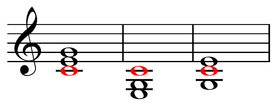

In the harmony of Western art music a chord is in root position when the tonic note is the lowest in the chord, and the other notes are above it. When the lowest note is not the tonic, the chord is inverted. Chords that have many constituent notes can have many different inverted positions as shown below for the C major chord:
| Bass note | Position | Order of notes | Notation |
|---|---|---|---|
| C | root position | C E G or C G E | 5 3 as G is a fifth above C and E is a third above C |
| E | first inversion | E G C or E C G | 6 3 as C is a sixth above E and G is a third above E |
| G | second inversion | G C E or G E C | 6 4 as E is a sixth above G and C is a fourth above G |
Further, a four-note chord can be inverted to four different positions by the same method as triadic inversion. For example, a G7 chord can be in root position (G as bass note); first inversion (B as bass note); second inversion (D as bass note); or third inversion (F as bass note). Where guitar chords are concerned the term "inversion" is used slightly differently; to refer to stock fingering "shapes".[33]
Secundal, tertian, and quartal chords
| Chord | Component intervals |
|---|---|
| Secundal | Seconds: major second, minor second |
| Tertian | Thirds: major third, minor third |
| Quartal | Fourth: perfect fourth, augmented fourth |
| Quintal | Fifths: diminished fifth, perfect fifth |
Many chords are a sequence of ascending notes separated by intervals of roughly the same size. Chords can be classified into different categories by this size:
- Tertian chords can be decomposed into a series of (major or minor) thirds. For example, the C major triad (C–E–G) is defined by a sequence of two intervals, the first (C–E) being a major third and the second (E–G) being a minor third. Most common chords are tertian.
- Secundal chords can be decomposed into a series of (major or minor) seconds. For example, the chord C–D–E♭ is a series of seconds, containing a major second (C–D) and a minor second (D–E♭).
- Quartal chords can be decomposed into a series of (perfect or augmented) fourths. Quartal harmony normally works with a combination of perfect and augmented fourths. Diminished fourths are enharmonically equivalent to major thirds, so they are uncommon.[35] For example, the chord C–F–B is a series of fourths, containing a perfect fourth (C–F) and an augmented fourth/tritone (F–B).
These terms can become ambiguous when dealing with non-diatonic scales, such as the pentatonic or chromatic scales. The use of accidentals can also complicate the terminology. For example, the chord B♯–E–A♭ appears to be quartal, as a series of diminished fourths (B♯–E and E–A♭), but it is enharmonically equivalent to (and sonically indistinguishable from) the tertian chord C–E–G♯, which is a series of major thirds (C–E and E–G♯).
Harmonic content
The notes of a chord form intervals with each of the other notes of the chord in combination. A 3-note chord has 3 of these harmonic intervals, a 4-note chord has 6, a 5-note chord has 10, a 6-note chord has 15.[36] The absence, presence, and placement of certain key intervals plays a large part in the sound of the chord, and sometimes of the selection of the chord that follows.
A chord containing tritones is called tritonic; one without tritones is atritonic. Harmonic tritones are an important part of dominant seventh chords, giving their sound a characteristic tension, and making the tritone interval likely to move in certain stereotypical ways to the following chord.[37] Tritones are also present in diminished seventh and half-diminished chords.
A chord containing semitones, whether appearing as Minor seconds or Major sevenths, is called hemitonic; one without semitones is anhemitonic. Harmonic semitones are an important part of Major seventh chords, giving their sound a characteristic high tension, and making the harmonic semitone likely to move in certain stereotypical ways to the following chord.[38] A chord containing Major sevenths but no Minor seconds is much less harsh in sound than one containing Minor seconds as well.
Other chords of interest might include the
- Diminished chord, which has many minor thirds and no major thirds, many tritones but no perfect fifths
- Augmented chord, which has many major thirds and no minor thirds or perfect fifths
- Dominant seventh diminished five chord, which has many major thirds and tritones and no minor thirds or perfect fifths
Triads
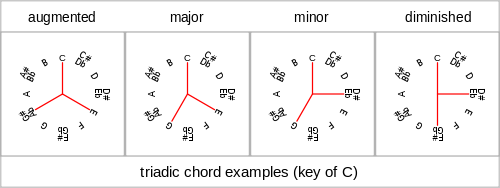
Triads, also called triadic chords, are tertian chords with three notes. The four basic triads are described below.
| Component intervals | Chord symbol | Notes | Audio | ||
|---|---|---|---|---|---|
| Third | Fifth | ||||
| Major triad | major | perfect | C, CM, Cmaj, CΔ, Cma | C E G | |
| Minor triad | minor | perfect | Cm, Cmin, C−, Cmi | C E♭ G | |
| Augmented triad | major | augmented | Caug, C+, C+ | C E G♯ | |
| Diminished triad | minor | diminished | Cdim, Co, Cm(♭5) | C E♭ G♭ | |
Seventh chords
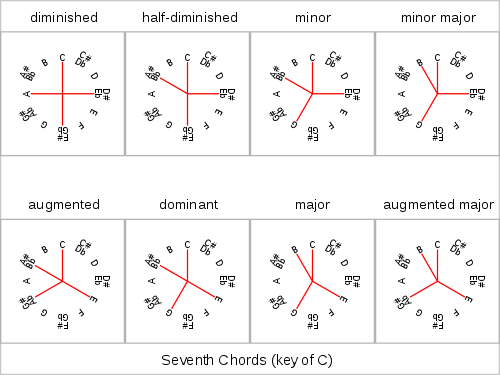
Seventh chords are tertian chords, constructed by adding a fourth note to a triad, at the interval of a third above the fifth of the chord. This creates the interval of a seventh above the root of the chord, the next natural step in composing tertian chords. The seventh chord built on the fifth step of the scale (the dominant seventh) is the only one available in the major scale: it contains all three notes of the diminished triad of the seventh and is frequently used as a stronger substitute for it.
There are various types of seventh chords depending on the quality of both the chord and the seventh added. In chord notation the chord type is sometimes superscripted and sometimes not (e.g. Dm7, Dm7, and Dm7 are all identical).
| Component intervals | Chord symbol | Notes | Audio | |||
|---|---|---|---|---|---|---|
| Third | Fifth | Seventh | ||||
| Diminished seventh | minor | diminished | diminished | Co7, Cdim7 | C E♭ G♭ B | |
| Half-diminished seventh | minor | diminished | minor | Cø7, Cm7♭5, C−(♭5) | C E♭ G♭ B♭ | |
| Minor seventh | minor | perfect | minor | Cm7, Cmin7, C−7, | C E♭ G B♭ | |
| Minor major seventh | minor | perfect | major | CmM7, Cmmaj7, C−(j7), C−Δ7, C−M7 | C E♭ G B | |
| Dominant seventh | major | perfect | minor | C7, Cdom7 | C E G B♭ | |
| Major seventh | major | perfect | major | CM7, CM7, Cmaj7, CΔ7, Cj7 | C E G B | |
| Augmented seventh | major | augmented | minor | C+7, Caug7, C7+, C7+5, C7♯5 | C E G♯ B♭ | |
| Augmented major seventh | major | augmented | major | C+M7, CM7+5, CM7♯5, C+j7, C+Δ7 | C E G♯ B | |
Extended chords

Extended chords are triads with further tertian notes added beyond the seventh: the ninth, eleventh, and thirteenth chords. After the thirteenth, any notes added in thirds duplicate notes elsewhere in the chord; all seven notes of the scale are present in the chord, so adding more notes does not add new pitch classes. Such chords may be constructed only by using notes that lie outside the diatonic seven-note scale.
| Components | Chord symbol | Notes | Audio | ||||
|---|---|---|---|---|---|---|---|
| Chord | Interval(s) | ||||||
| Dominant ninth | dominant seventh | major ninth | — | — | C9 | C E G B♭ D | |
| Dominant eleventh | dominant seventh (the third is usually omitted) | major ninth | perfect eleventh | — | C11 | C E G B♭ D F | |
| Dominant thirteenth | dominant seventh | major ninth | perfect eleventh (usually omitted) | major thirteenth | C13 | C E G B♭ D F A | |
Other extended chords follow similar rules, so that for example maj9, maj11, and maj13 contain major seventh chords rather than dominant seventh chords, while m9, m11, and m13 contain minor seventh chords.
Altered chords
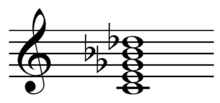
The third and seventh of the chord are always determined by the symbols shown above (the root cannot be so altered without changing the name of the chord, while the third cannot be altered without altering the chord's quality). Nevertheless, the fifth, ninth, eleventh and thirteenth may all be chromatically altered by accidentals. These are noted alongside the altered element. Accidentals are most often used with dominant seventh chords. Altered dominant seventh chords (C7alt) may have a minor ninth, a sharp ninth, a diminished fifth or an augmented fifth (see Levine's Jazz Theory). Some write this as C7+9, which assumes also the minor ninth, diminished fifth and augmented fifth (see Aebersold's Scale Syllabus). The augmented ninth is often referred to in blues and jazz as a blue note, being enharmonically equivalent to the minor third or tenth. When superscripted numerals are used the different numbers may be listed horizontally (as shown) or else vertically.
| Components | Chord symbol | Notes | Audio | ||
|---|---|---|---|---|---|
| Chord | Interval(s) | ||||
| Seventh augmented fifth | dominant seventh | augmented fifth | C7+5, C7♯5 | ||
| Seventh minor ninth | dominant seventh | minor ninth | C7−9, C7♭9 | ||
| Seventh sharp ninth | dominant seventh | augmented ninth | C7+9, C7♯9 | ||
| Seventh augmented eleventh | dominant seventh | augmented eleventh | C7+11, C7♯11 | ||
| Seventh diminished thirteenth | dominant seventh | minor thirteenth | C7−13, C7♭13 | ||
| Half-diminished seventh | minor seventh | diminished fifth | Cø, Cø7, Cm7♭5 | ||
Added tone chords
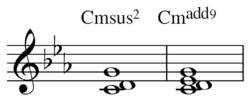
An added tone chord is a triad chord with an added, non-tertian note, such as the commonly added sixth as well as chords with an added second (ninth) or fourth (eleventh) or a combination of the three. These chords do not include "intervening" thirds as in an extended chord. Added chords can also have variations. Thus madd9, m4 and m6 are minor triads with extended notes.
Sixth chords can belong to either of two groups. One is first inversion chords and added sixth chords that contain a sixth from the root.[40] The other group is inverted chords in which the interval of a sixth appears above a bass note that is not the root.[41]
The major sixth chord (also called, sixth or added sixth with the chord notation 6, e.g., C6) is by far the most common type of sixth chord of the first group. It comprises a major triad with the added major sixth above the root, common in popular music.[18] For example, the chord C6 contains the notes C-E-G-A. The minor sixth chord (min6 or m6, e.g., Cm6) is a minor triad, still with a major 6. For example, the chord Cm6 contains the notes C-E♭-G-A}}.
The augmented sixth chord usually appears in chord notation as its enharmonic equivalent, the seventh chord. This chord contains two notes separated by the interval of an augmented sixth (or, by inversion, a diminished third, though this inversion is rare). The augmented sixth is generally used as a dissonant interval most commonly used in motion towards a dominant chord in root position (with the root doubled to create the octave the augmented sixth chord resolves to) or to a tonic chord in second inversion (a tonic triad with the fifth doubled for the same purpose). In this case, the tonic note of the key is included in the chord, sometimes along with an optional fourth note, to create one of the following (illustrated here in the key of C major):
- Italian augmented sixth: A♭, C, F♯
- French augmented sixth: A♭, C, D, F♯
- German augmented sixth: A♭, C, E♭, F♯
The augmented sixth family of chords exhibits certain peculiarities. Since they are not based on triads, as are seventh chords and other sixth chords, they are not generally regarded as having roots (nor, therefore, inversions), although one re-voicing of the notes is common (with the namesake interval inverted to create a diminished third).[42]
The second group of sixth chords includes inverted major and minor chords, which may be called sixth chords in that the six-three (6
3) and six-four (6
4) chords contain intervals of a sixth with the bass note, though this is not the root. Nowadays this is mostly for academic study or analysis (see figured bass) but the neapolitan sixth chord is an important example; a major triad with a flat supertonic scale degree as its root that is called a "sixth" because it is almost always found in first inversion. Though a technically accurate Roman numeral analysis would be ♭II, it is generally labelled N6. In C major, the chord is notated (from root position) D♭, F, A♭. Because it uses chromatically altered tones this chord is often grouped with the borrowed chords but the chord is not borrowed from the relative major or minor and it may appear in both major and minor keys.
| Components | Chord symbol | Notes | Audio | |||
|---|---|---|---|---|---|---|
| Chord | Interval(s) | |||||
| Add nine | major triad | major ninth | — | C2, Cadd9 | C E G D | |
| Add fourth | major triad | perfect fourth | — | C4, Cadd11 | C E G F | |
| Add sixth | major triad | major sixth | — | C6 | C E G A | |
| Six-nine | major triad | major sixth | major ninth | C6/9 | C E G A D | — |
| Seven-six | major triad | major sixth | minor seventh | C7/6 | C E G A B♭ | – |
| Mixed-third | major triad | minor third | — | — | C E♭ E G | |
Suspended chords
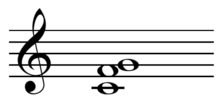
A suspended chord, or "sus chord" (sometimes wrongly thought to mean sustained chord), is a chord in which the third is replaced by either the second or the fourth. This produces two main chord types: the suspended second (sus2) and the suspended fourth (sus4). The chords, Csus2 and Csus4, for example, consist of the notes C D G and C F G, respectively. There is also a third type of suspended chord, in which both the second and fourth are present, for example the chord with the notes C D F G.
The name suspended derives from an early polyphonic technique developed during the common practice period, in which a stepwise melodic progress to a harmonically stable note in any particular part was often momentarily delayed or suspended by extending the duration of the previous note. The resulting unexpected dissonance could then be all the more satisfyingly resolved by the eventual appearance of the displaced note. In traditional music theory the inclusion of the third in either chord would negate the suspension, so such chords would be called added ninth and added eleventh chords instead.
In modern layman usage the term is restricted to the displacement of the third only and the dissonant second or fourth no longer needs to be held over (prepared) from the previous chord. Neither is it now obligatory for the displaced note to make an appearance at all though in the majority of cases the conventional stepwise resolution to the third is still observed. In post-bop and modal jazz compositions and improvisations suspended seventh chords are often used in nontraditional ways: these often do not function as V chords, and do not resolve from the fourth to the third. The lack of resolution gives the chord an ambiguous, static quality. Indeed, the third is often played on top of a sus4 chord. A good example is the jazz standard, Maiden Voyage.
Extended versions are also possible, such as the seventh suspended fourth, which, with root C, contains the notes C F G B♭ and is notated as C7sus4 ![]()
| Components | Chord symbol | Notes | Audio | ||||
|---|---|---|---|---|---|---|---|
| Chord | Interval(s) | ||||||
| suspended second | open fifth | major second | — | — | Csus2 | C D G | |
| suspended fourth | open fifth | perfect fourth | — | — | Csus4 | C F G | |
| Jazz sus | open fifth | perfect fourth | minor seventh | major ninth | C9sus4 | C F G B♭ D | |
Borrowed chords

A borrowed chord is one from a different key than the home key, the key of the piece it is used in. The most common occurrence of this is where a chord from the parallel major or minor key is used. Particularly good examples can be found throughout the works of composers such as Schubert. For instance, for a composer working in the C major key, a major ♭III chord (e.g., an E♭ major chord) would be borrowed, as this chord appears only in the C minor key. Although borrowed chords could theoretically include chords taken from any key other than the home key, this is not how the term is used when a chord is described in formal musical analysis.
When a chord is analysed as "borrowed" from another key it may be shown by the Roman numeral corresponding with that key after a slash. For example, V/V (pronounced "five of five") indicates the dominant chord of the dominant key of the present home-key. The dominant key of C major is G major so this secondary dominant is the chord of the fifth degree of the G major scale, which is D major (which can also be described as II relative to the key of C major, not to be confused with the supertonic ii namely D minor.). If used for a significant duration, the use of the D major chord may cause a modulation to a new key (in this case to G major).
Borrowed chords are widely used in Western popular music and rock music. For example, there are a number of songs in E major which use the ♭III chord (e.g., a G major chord used in an E major song), the ♭VII chord (e.g., a D major chord used in an E major song) and the ♭VI chord (e.g., a C major chord used in an E major song). All of these chords are "borrowed" from the key of E minor.
References
- ↑ Benward & Saker (2003). Music: In Theory and Practice, Vol. I, pp. 67, 359. Seventh Edition. ISBN 978-0-07-294262-0."A chord is a harmonic unit with at least three different tones sounding simultaneously." "A combination of three or more pitches sounding at the same time."
- ↑ Károlyi, Otto (1965). Introducing Music. Penguin Books. p. 63.
Two or more notes sounding simultaneously are known as a chord.
- ↑ Mitchell, Barry (January 16, 2008). "An explanation for the emergence of Jazz (1956)", Theory of Music.
- ↑ Linkels, Ad, The Real Music of Paradise", In Broughton, Simon and Ellingham, Mark with McConnachie, James and Duane, Orla (Ed.), World Music, Vol. 2: Latin & North America, Caribbean, India, Asia and Pacific, pp. 218–29. Rough Guides Ltd, Penguin Books. ISBN 1-85828-636-0
- 1 2 Malm, William P. (1996). Music Cultures of the Pacific, the Near East, and Asia. p.15. ISBN 0-13-182387-6. Third edition: "Indeed, this harmonic orientation is one of the major differences between Western and much non-Western music."
- ↑ Moylan, William (2014-06-20). Understanding and Crafting the Mix: The Art of Recording. CRC Press. ISBN 9781136117589.
- 1 2 3 Arnold Schoenberg, Structural Functions of Harmony, Faber and Faber, 1983, pp. 1–2.
- ↑ Benward & Saker (2003), p. 77.
- ↑ Merriam-Webster, Inc. (1995). "Chord", Merriam-Webster's dictionary of English usage, p.243. ISBN 978-0-87779-132-4.
- ↑ "Chord", Oxford Dictionaries.
- ↑ Dahlhaus, Car. "Harmony". In Deane L. Root. Grove Music Online. Oxford Music Online. Oxford University Press. (subscription required)
- ↑ Károlyi, Ottó, Introducing Music, p. 63. England: Penguin Books.
- ↑ Arnold Schoenberg, Theory of Harmony, p.26: "It is required of a chord that it consist of three different tones."
- ↑ Schellenberg, E. Glenn; Bigand, Emmanuel; Poulin-Charronnat, Benedicte; Garnier, Cecilia; Stevens, Catherine (Nov 2005). "Children's implicit knowledge of harmony in Western music". Developmental Science. 8 (8): 551–566. doi:10.1111/j.1467-7687.2005.00447.x. PMID 16246247.
- ↑ Duarter, John (2008). Melody & Harmony for Guitarists, p.49. ISBN 978-0-7866-7688-0.
- ↑ Benward & Saker (2003), p.185.
- 1 2 Benward & Saker (2003), p.70.
- 1 2 3 4 Benward & Saker (2003), p. 77.
- ↑ Benward & Saker (2003), p.100.
- 1 2 Benward & Saker (2003), p.201.
- ↑ Benward & Saker (2003), p.220.
- ↑ Benward & Saker (2003), p.231.
- ↑ Benward & Saker (2003), p.274.
- ↑ Winston Harrison, The Rockmaster System: Relating Ongoing Chords to the Keyboard – Rock, Book 1, Dellwin Publishing Co. 2005, p. 33
- ↑ Pachet, François, Surprising Harmonies, International Journal on ComputingAnticipatory Systems, 1999. Archived March 30, 2011, at the Wayback Machine.
- ↑ Pen, Ronald (1992). Introduction to Music, p.81. McGraw-Hill, ISBN 0-07-038068-6. "In each case the note that forms the foundation pitch is called the root, the middle tone of the chord is designated the third (because it is separated by the interval of a third from the root), and the top tone is referred to as the fifth (because it is a fifth away from the root)."
- ↑ William G Andrews and Molly Sclater (2000). Materials of Western Music Part 1, p. 227. ISBN 1-55122-034-2.
- ↑ Benward & Saker (2003). Music: In Theory and Practice, Vol. I, pp. 74–75. Seventh Edition. ISBN 978-0-07-294262-0.
- ↑ The assumption that a chord can be indicated "the German way"; using only capital or small letters ("C" for Major, or "c" for minor) is a fatal misunderstanding. The German tradition only uses this when describing the tonality of the key (g-minor, or F#-Major). To try to use this for chords is woefully inaccurate and shouldn't be used.
- ↑ Haerle, Dan (1982). The Jazz Language: A Theory Text for Jazz Composition and Improvisation, p. 30. ISBN 978-0-7604-0014-2.
- ↑ Policastro, Michael A. (1999). Understanding How to Build Guitar Chords and Arpeggios, p. 168. ISBN 978-0-7866-4443-8.
- ↑ Benward & Saker (2003), p. 92.
- ↑ Bert Weedon, Play in a Day, Faber Music Ltd, ISBN 0-571-52965-8, passim – among a wide range of other guitar tutors
- ↑ Dufrenne, Mikel (1989). The Phenomenology of Aesthetic Experience, p. 253. ISBN 0-8101-0591-8.
- ↑ Connie E. Mayfield (2012) "Theory Essentials", p. 523. ISBN 1-133-30818-X.
- ↑ Hanson, Howard. (1960) Harmonic Materials of Modern Music, pp. 7ff. New York: Appleton-Century-Crofts. LOC 58-8138.
- ↑ Benjamin, Horvit, and Nelson (2008). Techniques and Materials of Music, pp. 46–47. ISBN 0-495-50054-2.
- ↑ Benjamin, Horvit, and Nelson (2008). Techniques and Materials of Music, pp. 48–49. ISBN 0-495-50054-2.
- ↑ Hawkins, Stan. "Prince- Harmonic Analysis of 'Anna Stesia'", pp. 329, 334n7, Popular Music, Vol. 11, No. 3 (Oct., 1992), pp. 325–35.
- ↑ Miller, Michael (2005). The Complete Idiot's Guide to Music Theory, p. 119. ISBN 978-1-59257-437-7.
- ↑ Piston, Walter (1987). Harmony (5th ed.), p. 66. New York: W.W. Norton & Company. ISBN 0-393-95480-3.
- ↑ Bartlette, Christopher, and Steven G. Laitz (2010). Graduate Review of Tonal Theory. New York: Oxford University Press. ISBN 978-0-19-537698-2
Sources
- Grout, Donald Jay (1960). A History Of Western Music. Norton Publishing.
- Dahlhaus, Carl. Gjerdingen, Robert O. trans. (1990). Studies in the Origin of Harmonic Tonality, p. 67. Princeton University Press. ISBN 0-691-09135-8.
- Goldman (1965). Cited in Nattiez (1990).
- Jones, George T. (1994). HarperCollins College Outline Music Theory. ISBN 0-06-467168-2.
- Nattiez, Jean-Jacques (1990). Music and Discourse: Toward a Semiology of Music (Musicologie générale et sémiologue, 1987). Translated by Carolyn Abbate (1990). ISBN 0-691-02714-5.
- Norman Monath, Norman (1984). How To Play Popular Piano In 10 Easy Lessons. Fireside Books. ISBN 0-671-53067-4.
- Stanley Sadie and John Tyrrell, eds. (2001). The New Grove Dictionary of Music and Musicians. ISBN 1-56159-239-0.
- Surmani, Andrew (2004). Essentials of Music Theory: A Complete Self-Study Course for All Musicians. ISBN 0-7390-3635-1.
Further reading
- Benward, Bruce & Saker, Marilyn (2002). Music in Theory and Practice, Volumes I & II (7th ed.). New York: McGraw Hill. ISBN 0-07-294262-2.
- Mailman, Joshua B. (2015). "Schoenberg's Chordal Experimentalism Revealed Through Representational Hierarchy Association (RHA), Contour Motives, and Binary State Switching" (PDF). Music Theory Spectrum. 37 (2): 224–52.
- Persichetti, Vincent (1961). Twentieth-century Harmony: Creative Aspects and Practice. New York: W. W. Norton. ISBN 0-393-09539-8. OCLC 398434.
- Schejtman, Rod (2008). Music Fundamentals. The Piano Encyclopedia. ISBN 978-987-25216-2-2.
External links



